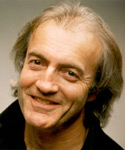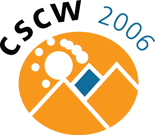Conference Program
Closing Plenary

Bill Buxton
"Tufte Doesn't Understand the GENESYS of PowerPoint"
Perhaps it is a sign of aging, but I know less now than I did when CSCW emerged as a distinct discipline. That may not be a bad thing. But the fact is, I am no longer sure what a computer is. I strongly suspect that some of the supports that we built over the years are actually cages. What passes for collaboration is too often uniform conviction. And as too many people will be too ready to tell you, I don’t know the meaning of work. So much for my understanding of CSCW.
And what of our field? Have we helped people collaborate more? Has technology helped? In some forums - such as Wikipedia, for example - it would be foolish to argue to the negative. In others, the case is less clear. For example, take one of the most commonly used technologies used in meetings, PowerPoint. Tufte, would say that it has hurt, not helped. While acknowledging Kranzberg’s first law - Technology is not good, technology is not bad, but nor is it neutral - I wonder if this is any more valid than it is to blame a pencil for a bad or inappropriate drawing. Should we blame the tool that is too often inappropriately used to fill a particular gap, or the fact that there is no appropriate plug with which to fill it? I cannot blame my car for being a bad bus.
What we can do is go back to first principals, and recognize that presentation is too often confused with ideation and exploration. Telling with asking. And division of labour and communication with collaboration.
And if I look at every-day tools from a previous era to reframe this in technological terms, we too often confuse a slide-show for a blackboard. And yes, the very same technology that is supposed to be supporting us has been a major culprit in enabling that confusion.
So turning Kranzberg’s law to our advantage, it is back to the blackboard that we shall go. And see how the Genesys of a remedy flows from Lincoln Lab in 1969, to today, including (with more than a little irony) through PowerPoint.
About Bill Buxton
Bill Buxton is a designer and a researcher concerned with human aspects of technology. His work reflects a particular interest in the use of technology to support creative activities such as design, film making and music. Buxton's research specialties include technologies, techniques and theories of input to computers, technology mediated human-human collaboration, and ubiquitous computing.
In December 2005, he was appointed Principal Researcher at Microsoft Research. Prior to that, he was Principal of his own Toronto-based boutique design and consulting firm, Buxton Design, where his time was split between working for clients, lecturing, and trying to finish a long-delayed book on sketching and interaction design. He also has an association with Bruce Mau Design of Toronto, where he is honourary Chief Scientist. As well, he is an Associate Professor in the Department of Computer Science at the University of Toronto, where he still works with graduate students.
In 1995, Buxton became the third recipient of the Canadian Human-Computer Communications Society Award for contributions to research in computer graphics and human-computer interaction, and was given the New Media Visionary of the Year Award at the 2000 Canadian New Media Awards. In 2002, he was elected to the CHI Academy, and Time Magazine named him one of the top 5 designers in Canada. In 2001, The Hollywood Reporter named him one of the 10 most influential innovators in Hollywood. In October, 2005, he and Gord Kurtenbach received the "Lasting Impact Award", from ACM UIST 2005, which was awarded for their 1991 paper, Issues in Combining Marking and Direct Manipulation Techniques.
Outside of work, Buxton loves the outdoors. He is especially passionate about mountains, including skiing, climbing, and touring, both in summer and winter. This interest extends to the written word, as manifest in his extensive collection on the history and literature of Central Asia, mountaineering, and exploration. In addition, he is an avid cyclist, and active in kayaking, SCUBA diving and windsurfing. He is an accomplished equestrian , and in 1996 was awarded the Veteran Rider of the Year award from the Ontario Horse Trials Association, and in 2000 was named to the Talent Squad of the National Eventing Team. Finally, he has a life-long fascination with art and his wife, who owns and operates a contemporary art gallery, Gallery 888, in Toronto, Canada.


